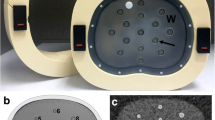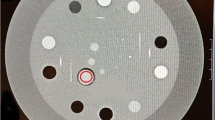Abstract
Purpose
To assess the impact of patient habitus, acquisition parameters, detector efficiencies, and reconstruction techniques on the accuracy of iodine quantification using dual-source dual-energy CT (DECT).
Materials and methods
Two phantoms simulating small and large patients contained 20 iodine solutions mimicking vascular and parenchymal enhancement from saline isodensity to 400 HU and 30 iodine solutions simulating enhancement of the urinary collecting system from 400 to 2,000 HU. DECT acquisition (80/140 kVp and 100/140 kVp) was performed using two DECT systems equipped with standard and integrated electronics detector technologies. DECT raw datasets were reconstructed using filtered backprojection (FBP), and iterative reconstruction (SAFIRE I/V).
Results
Accuracy for iodine quantification was significantly higher for the small compared to the large phantoms (9.2 % ± 7.5 vs. 24.3 % ± 26.1, P = 0.0001), the integrated compared to the conventional detectors (14.8 % ± 20.6 vs. 18.8 % ± 20.4, respectively; P = 0.006), and SAFIRE V compared to SAFIRE I and FBP reconstructions (15.2 % ± 18.1 vs. 16.1 % ± 17.6 and 18.9 % ± 20.4, respectively; P ≤ 0.003). A significant synergism was observed when the most effective detector and reconstruction techniques were combined with habitus-adapted dual-energy pairs.
Conclusion
In a second-generation dual-source DECT system, the accuracy of iodine quantification can be substantially improved by an optimal choice and combination of acquisition parameters, detector, and reconstruction techniques.
Key Points
• Iodine quantification techniques are not immune to error
• Systematic deviations between the measured and true iodine concentrations exist
• Acquisition parameters, detector efficiencies, and reconstruction techniques impact accuracy of iodine quantification


Similar content being viewed by others
Abbreviations
- APE:
-
absolute percentage error
- ANOVA:
-
analysis of variance
- CTDIvol :
-
CT dose index volume
- DECT:
-
dual-energy CT
- FBP:
-
filtered backprojection
- GLM:
-
general linear model
- ROI:
-
region of interest
- SAFIRE:
-
sinogram affirmed iterative reconstruction
References
Chiro GD, Brooks RA, Kessler RM et al (1979) Tissue signatures with dual-energy computed tomography. Radiology 131:521–523
Cann CE, Gamsu G, Birnberg FA, Webb WR (1982) Quantification of calcium in solitary pulmonary nodules using single- and dual-energy CT. Radiology 145:493–496
Genant HK, Boyd D (1977) Quantitative bone mineral analysis using dual energy computed tomography. Invest Radiol 12:545–551
Schmidt-Bindert G, Henzler T, Chu TQ et al (2012) Functional imaging of lung cancer using dual energy CT: how does iodine related attenuation correlate with standardized uptake value of 18FDG-PET-CT? Eur Radiol 22:93–103
Apfaltrer P, Meyer M, Meier C et al (2012) Contrast-enhanced dual-energy CT of gastrointestinal stromal tumors. Is iodine-related attenuation a potential indicator of tumor response? Invest Radiol 47:65–70
Ascenti G, Mileto A, Krauss B et al (2013) Distinguishing enhancing from nonenhancing renal masses with dual-source dual-energy CT: iodine quantification versus standard enhancement measurements. Eur Radiol 23:2288–2295
Chandarana H, Megibow AJ, Cohen BA et al (2011) Iodine quantification with dual-energy CT: phantom study and preliminary experience with renal masses. AJR Am J Roentgenol 196:W693–W700
Koonce JD, Vliegenthart R, Schoepf UJ et al (2014) Accuracy of dual-energy computed tomography for the measurement of iodine concentration using cardiac CT protocols: validation in a phantom model. Eur Radiol 24:512–518
Feuerlein S, Heye TJ, Bashir MR, Boll DT (2012) Iodine quantification using dual-energy multidetector computed tomography imaging: phantom study assessing the impact of iterative reconstruction schemes and patient habitus on accuracy. Invest Radiol 47:656–661
Gatenby RA, Grove O, Gillies RJ (2013) Quantitative imaging in cancer evolution and ecology. Radiology 269:8–15
Duan X, Wang J, Leng S, Schmidt B, Allmendinger T, Grant K, Flohr T, McCollough CH (2013) Electronic noise in CT detectors: Impact on image noise and artifacts. AJR Am J Roentgenol 201:W626–632
Primak AN, Giraldo JC, Eusemann CD et al (2010) Dual-source dual-energy CT with additional tin filtration: dose and image quality evaluation in phantoms and in vivo. AJR Am J Roentgenol 195:1164–1174
Pontana F, Pagniez J, Duhamel A et al (2013) Reduced-dose low-voltage chest CT angiography with sinogram-affirmed iterative reconstruction versus standard-dose filtered back projection. Radiology 267:609–618
Li Y, Shi G, Wang S, Wang S, Wu R (2013) Iodine quantification with dual-energy CT: phantom study and preliminary experience with VX2 residual tumour in rabbits after radiofrequency ablation. Br J Radiol 86:20130143
Morsbach F, Bickelhaupt S, Rätzer S, Schmidt B, Alkadhi H (2014) Integrated circuit detector technology in abdominal CT: added value in obese patients. AJR Am J Roentgenol 202:368–374
Primak AN, Ramirez Giraldo JC, Liu X, Yu L, McCollough CH (2009) Improved dual-energy material discrimination for dual-source CT by means of additional spectral filtration. Med Phys 36:1359–1369
Armato SG, Goldmacher GV, Schwartz LH (2014) Quantitative imaging biomarkers alliance (QIBA). http://qibawiki.rsna.org/index.php?title=Main_Page. Accessed 27 Feb 2014
Yu L, Leng S, McCollough CH (2012) Dual-energy CT-based monochromatic imaging. AJR Am J Roentgenol 199:S9–S15
Acknowledgements
The scientific guarantor of this publication is Professor Daniel T. Boll. The authors of this manuscript declare no relationships with any companies, whose products or services may be related to the subject matter of the article. The authors state that this work has not received any funding. One of the authors (Daniel T. Boll) has significant statistical expertise. Institutional review board approval was not required because it is a phantom study. Methodology: prospective, experimental, performed at one institution.
Author information
Authors and Affiliations
Corresponding author
Rights and permissions
About this article
Cite this article
Marin, D., Pratts-Emanuelli, J.J., Mileto, A. et al. Interdependencies of acquisition, detection, and reconstruction techniques on the accuracy of iodine quantification in varying patient sizes employing dual-energy CT. Eur Radiol 25, 679–686 (2015). https://doi.org/10.1007/s00330-014-3447-8
Received:
Revised:
Accepted:
Published:
Issue Date:
DOI: https://doi.org/10.1007/s00330-014-3447-8




